Continuing the parade — Yibang Maocha.
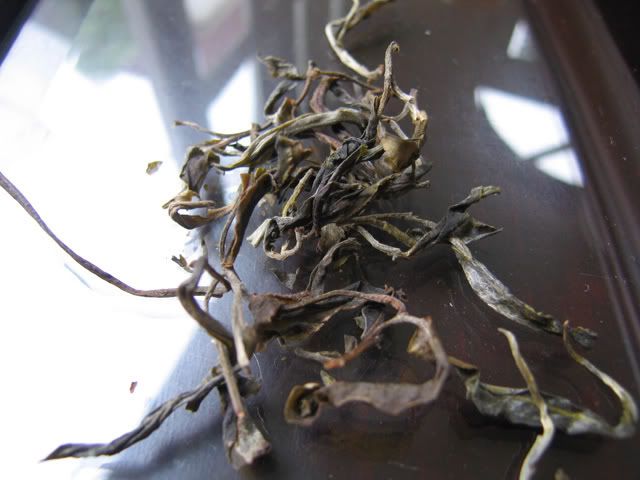
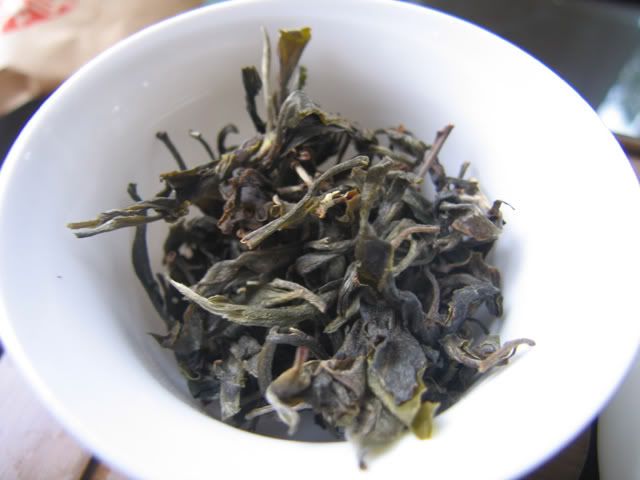
Yibang is north of Manzhuan, so it’s sort of two steps away from Yiwu. I think from the maps I’ve seen, if you want to go from Yiwu to Yibang you pretty much must pass through Manzhuan or surrounding areas. The dry leaves are a little skinny compared to the Manzhuan, yet a little bigger than the Yiwu. It seems more delicate.
The tea brews up a lighter coloured liquor than yesterday’s
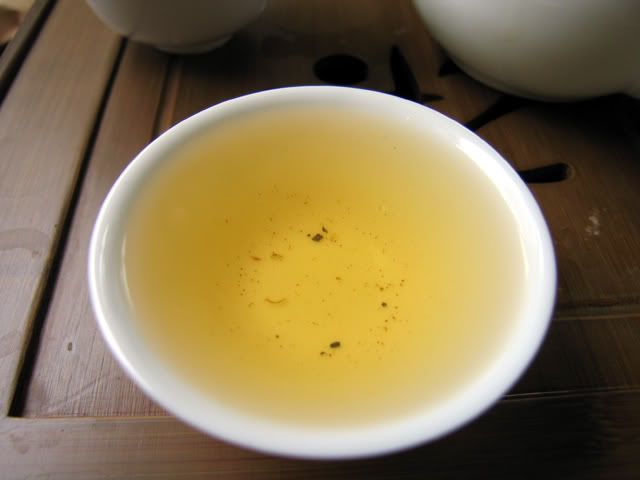
I did a little research, and it does seem that Manzhuan brews a deeper coloured tea than does Yiwu or Yibang.
The taste of the tea is… quite light, actually. Light in the sense that it is delicate, just like the leaves. Light is not the same as bland, for this is a strong tea. Not quite as strong as the Manzhuan yesterday with the penetration that it achieved, but the huigan is still very obvious and long lasting. If Yiwu is a little honey like, and Manzhuan a little spicy/fruity, then perhaps Yibang is a little minty, with a more up front bitterness that is not unpleasant. Rather, the bitterness is accompanied by what one might get from eating mint. It’s a very nice kind of bitterness and goes away quickly, leaving the aroma of the tea in your mouth.
One thing I have noticed with all three of these teas so far is that there is almost no residual aroma in the cup, the lid of the gaiwan, or in the fairness cup. If anything, the aroma on the lid is that of what they call “qing odor”, which is that slightly off smell that one gets from many young puerhs. This is not supposed to be taken as a sign of bad tea at all. Rather, it is a sign that the kill-green process was done at a temperature that was not too high. If there’s a very nice, fragrant, honey (or beans, or nutty, etc) aroma on the lid, then it could be a sign of the tea having gone through processing that are faulty in some ways — either through fermentation (oolong processing) or too high a temperature (green tea). Neither of them is commonly considered a good thing for aging potential. It takes a few years for a tea to clear this smell and turn it into something else, as far as I’ve seen.
The tea lasted a similarly long time as yesterday’s. It was rainy today, so the sky was darker and I took the pictures of the wet leaves inside. It’s too bad, but this will have to do.
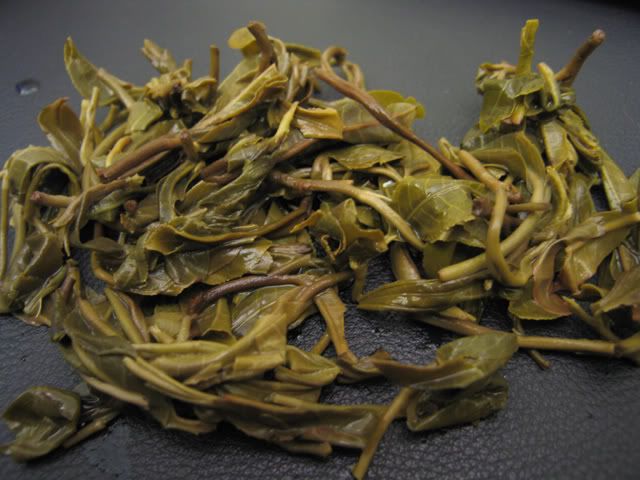
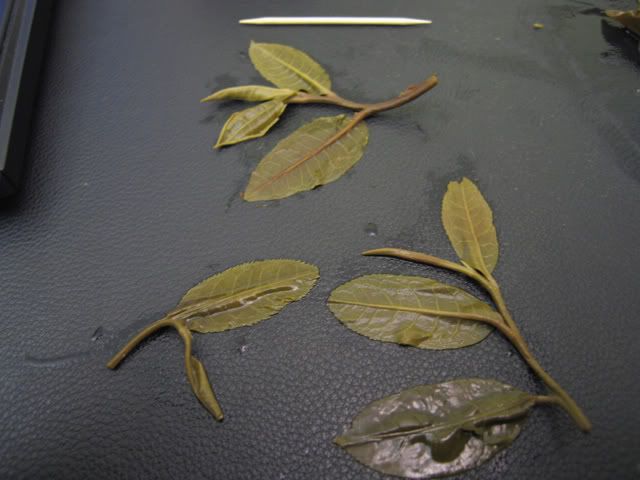

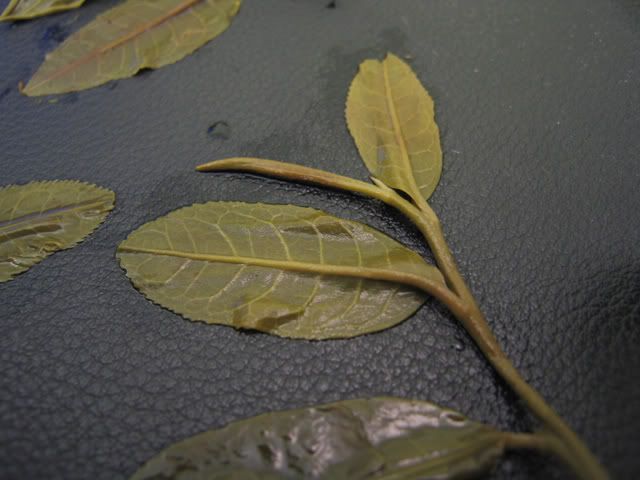
The leaves are lovely. They are small. Yet they show strength. So far, I think the strongest tea is the Manzhuan. Yiwu is the easiest on the tongue for the novice, and is also the one that has the most alluring aroma, but it lacks some of the strength of the other two. I think I brewed it with slightly less hot water, which might have been a factor. L still has a sample of the Yiwu, as does Action Jackson. I am hoping I can convince them to bring a sample over so I can use my same water/tools to brew the Yiwu again for a proper comparison.
I’m really enjoying drinking these maocha so far, and I really hope I can somehow find more of them, even if I have to pay. I don’t know if they’ll sell them, but I’ve asked. Let’s hope they do, because I want to keep some samples around for tasting a year later, 5 years later, and maybe even 10 years from now to see how they change over time. It will be an invaluable tool. But there’s no need to think ahead so far… tomorrow, I think I’ll go with Gedeng, which is west of Manzhuan and Yibang.

3 responses so far ↓
HobbesOxon // May 4, 2007 at 2:02 pm |
Luscious leaves. I’m keenly following your tasting through the mountains, thanks for the detail.
Do please let me know if you manage to find a source for these; I’m very interesting in acquiring some to put some personal experience alongside what I’ve read here.
Toodlepip,
Hobbes
MarshalN // May 4, 2007 at 2:07 pm |
Thanks, as this blog is (still) primarily for my own record keeping… I thought I should be as detailed as I can be without making it a chore. I am just not the kind of person who do the infusion by infusion notes. I tried, but it doesn’t work with me.
If I can find some, I’ll let you know. I don’t have high hopes though.
kibi_kibi // May 4, 2007 at 2:14 pm |
Sounds very interesting; I guess I’ve started to notice that very aromatic young Pu-erh tends to have some oddities in there too, so I think I’d agree that perhaps a strong lid aroma is not a good sign. Certainly its more of an oolong thing…
It’s a little odd that mao cha is so hard to find; these packs are really quite a good idea. Then again what Hou De had was quite similar, though there were only four, and the quality of a few of them was not as good as it could have been.
🙂
-vl.